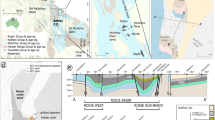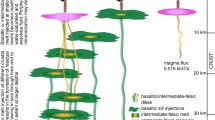Abstract
The Central Andes host some of the world’s largest porphyry copper deposits. The economic viability of these deposits is dependent on the size and quality of their supergene enrichment blanket. Published models that have strongly influenced exploration policy suggest that supergene enrichment ceased at 14 Ma due to an increase in aridity. Here we discuss these models using published geochronological, geomorphological and geological data. Geochronological data indicate that supergene oxidation and enrichment has been active between 17 and 27°S across the forearc of northern Chile and southern Peru from 44 to 6 Ma, and on the Bolivian Altiplano and Eastern Cordillera of Argentina from 11 Ma to present. There is evidence for cessation at 20, 14 and 6 Ma. However, a major problem is that as more geochronological data become available the age ranges and periods of enrichment increase. This suggests that the full spectrum of enrichment ages may not have been sampled. The relationship between supergene enrichment and the age of regional pediplain surface development is not well constrained. Only in two areas have surfaces related to enrichment been directly dated (southern Peru and south of 26°S in Chile) and suggest formation post 14 Ma. Sedimentological data indicate that a fluctuating arid/semi-arid climate prevailed across the Atacama Desert until between 4 and 3 Ma, climatic conditions that are thought to be favourable for supergene enrichment. The balance between uplift, erosion, burial and sufficient water supply to promote enrichment is complex. This suggests that a simple model for controlling supergene enrichment is unlikely to be widely applicable in northern Chile. General models that involve climatic desiccation at 14 Ma related to rainshadow development and/or the presence of an ancestral cold-upwelling Humboldt Current are not supported by the available geological evidence. The integration of disparate sedimentological, geomorphological and supergene age data will be required to fully understand the controls on and distribution of supergene oxidation and enrichment in the Central Andes.




Similar content being viewed by others
References
Alpers C, Brimhall G (1988) Middle Miocene climatic change in the Atacama Desert, northern Chile: evidence from supergene mineralization at La Escondida. Geol Soc Am Bull 100:1640–1656
Anderson JA (1982) Characteristics of leached capping and techniques of appraisal. In: Titley SR (ed) Advances in the geology of porphyry copper deposits, southwest North America. Tuscon Univ Arizona Press, Tucson, pp 245–287
Arehart GB, Kesler SE, O’Neil JR, Foland KA (1992) Evidence for the supergene origin of alunite in sediment-hosted micron gold deposits. Econ Geol 87:263–270
Betancourt JL, Latorre C, Rech JA, Quade J, Rylander KA (2000) A 22,000-Year record of monsoonal precipitation from northern Chile’s Atacama Desert. Science 289:1542–1545
Bouzari F, Clark AH (2002) Anatomy, evolution, and metallogenetic significance of the supergene orebody of the Cerro Colorado porphyry copper deposit, I Región, northern Chile. Econ Geol 97:1701–1740
Cameron EM, Leybourne MI, Kelley DL (2002) Exploring for deeply covered mineral deposits: formation of geochemical anomalies in northern Chile by earthquake-induced surface flooding of mineralised groundwaters. Geology 30:1007–1010
Chavez WX (2000) Supergene oxidation of copper deposits: zoning and distribution of copper oxide minerals. Soc Econ Geol Newsl 41:10–21
Chong G (1988) The Cenozoic saline deposits of the Chilean Andes between 18 and 27S. In: Bahlburg H., Breitkreuz C, Geise P (eds) The southern Central Andes. Springer, Berlin Heidelberg New York, pp 137–151
Clark AH, Meyer ES, Mortimer C, Sillitoe RH, Cooke RU, Snelling NJ (1967) Implications of the isotope ages of ignimbrite flows, southern Atacama Desert, Chile. Nature 215:723–724
Clark AH, Cook RU, Mortimer C, Sillitoe RH (1967a) Relationships between supergene mineral alteration and geomorphology—an interim report. Inst Min Metal Trans 76:B89–B96
Clark AH, Tosdal RM, Farrar E, Plazolles VA (1990) Geomorphologic environment and age of supergene enrichment of the Cuajone, Quellaveco, and Toquepala porphyry copper deposits, southern Peru. Econ Geol 85:1604–1628
Columba MC, Cunningham CG (1993) Geologic model for the mineral deposits of the La Joya district, Oruro, Bolivia. Econ Geol 88:701–708
Darke KE (1996) Supergene mineralisation in gold-rich bolivian polymetallic deposits. Unpublished PhD Thesis, University of Aberdeen, Scotland, p 356
Darke KE, Boyce AJ, Clapperton CM, Fallick AE, Redwood SD, Rice CM (1997) Supergene mineralization at the Korri Kollo gold mine, Bolivia. Explor Mining Geol 6:209–221
Flint S (1985) Alluvial fan and playa sedimentation in an Andean arid closed basin: the Paciencia Group, Antofagasta Province, Chile. J Geol Soc Lond 142:433–456
Galli-Oliver C (1967) Pediplain in northern Chile and the Andean uplift. Science 158:653–655
Garreaud RD, Vuille M, Clement AC (2003) The climate of the Altiplano: observed current conditions and mechanisms of past changes. Paleogog Paleoclim Paleoecol 194:5–22
Grosjean M (1994) Paleohydrology pf the Laguna Lejía (north Chilean Altiplano) and climatic implications for late-glacial times. Paleogeog Palaeoclim Palaeoecol 109:89–100
Grosjean M, Cartagena I, Geyh MA, Nunez L (2003) From proxy data to palaeoclimate interpretation: the mid-Holocene paradox of the Atacama Desert, northern Chile. Paleogeog Palaeoclim Palaeoecol 194:247–258
Gubbels TL, Isacks BL, Farrar E (1993) High-level surfaces, plateau uplift, and foreland development, Bolivian central Andes. Geology 21:695–698
Gustafson LB, Hunt JP (1975) The porphyry copper deposit at El Salvador, Chile. Econ Geol 70:857–912
Hartley AJ (2003) Andean uplift and climate change. J Geol Soc Lond 160:7–10
Hartley AJ, Chong G (2002) A late Pliocene age for the Atacama Desert: Implications for the desertification of western South America. Geology 30:43–46
Hartley AJ, Chong G, Turner P, May G, Kape SJ, Jolley EJ (2000) Development of a continental forearc: a Neogene example from the Central Andes, northern Chile. Geology 28:331–334
Hollingworth SE (1964) Dating the uplift of the Andes of northern Chile. Nature 201:17–20
Hollingworth SE, Rutland WR (1968) Studies of Andean uplift. Part 1-Post-Cretaceous evolution of the San Bartolo area, North Chile. Geol J 6:49–62
Houston J, Hartley AJ (2003) The central Andean west-slope rainshadow and its potential contribution to the origin of hyper-aridity in the Atacama Desert. Int J Clim 23:1453–1464
Jordan TE, Alonso RN (1987) Cenozoic stratigraphy and basin tectonics of the Andes Mountains, 20–28 south latitude. Am Assoc Pet Geol Bull 71:49–64
Latorre C, Betancourt JL, Rylander KA, Quade J (2002) Vegetation invasions into absolute desert: A 45,000-year rodent midden record from the Calama-Salar de Atacama basins, northern Chile (22–24°S). Geol Soc Am Bull 114:349–366
Long K, Ludington S, Du Bray E, Andre-Ramos O, McKee EH (1992) Geology and mineral deposits of the La Joya district Bolivia. Soc Econ Geol Newsl 10:12–17
Ludington S, Orris GJ, Cox DP, Long, KR, Asher-Bolinder S (1992) Mineral deposit models. USGS Bull 1975. Geology and Mineral Resources of the Altiplano and Cordillera Occidental, Bolivia, pp 63–90
Luandtwing MR, Dillenbeck ED, Leake MH, Heinrich CA (2002) Evolution of the breccia hosted porphyry CU-Mo-Au deposit at Agua Rica, Argentina: progressive unroofing of a magmatic hydrothermal system. Econ Geol 97:1273–1292
Marsh TM, Einaudi MT, McWilliams M (1997) 40Ar/39 Ar geochronology of Cu-Au and Su-Ag mineralization in the Potrerillos district, Chile. Econ Geol 92:784–806
May G, Hartley AJ, Stuart F, Chong G (1999) Tectonic signatures in arid continental basins: an example from the upper Miocene-Pleistocene, Calama basin, Andean forearc, northern Chile. Palaeogeog Palaeoclim Palaeoecol 151:55–77
May G, Hartley AJ, Chong G, Stuart F, Turner P, Kape SJ (2005) Oligocene to pleistocene lithostratigraphy, chronostratigraphy and tectono-sedimentary evolution of the Calama Basin, northern Chile. Rev Geol Chile 32:33–60
Mortimer C (1973) The Cenozoic history of the southern Atacama desert, Chile. J Geol Soc Lond 129:505–526
Mortimer C (1980) Drainage evolution of the Atacama Desert of northernmost Chile. Rev Geol Chile 11:3–28
Mortimer C, Saric N (1972) Landform evolution in the coastal region of Tarapacà Province, Chile. Rev Géomorph Dyn 21:162–170
Mortimer C, Saric N (1975) Cenozoic studies in northernmost Chile. Geol Rund 64:395–420
Mortimer C, Farrar E, Saric N (1974) K-Ar ages from tertiary lavas of the northernmost Chilean Andes. Geol Rund 63:484–493
Mote TI, Becker TA, Renne P, Brimhall GH (2001) Chronology of exotic mineralization at El Salvador, Chile, by 40Ar/39 Ar dating of copper wad and supergene alunite. Econ Geol 96:351–366
Naranjo JA, Paskoff RP (1985) Evolution Cenozoica del Piedemonte Andino en la Pampa del Tamurugal, Norte de Chile (18°–21°S). Congr Geol Chile Antofagasta, No. 4, 5:149–165
Naranjo JA, Paskoff R, Ramírez CF (1994) Morphostratigraphic evolution of the northwestern margin of the Salar de Atacama basin (23°S–68°W). Rev Geol Chile 21:91–103
Ossandón G, Freraut C, Gustafson LB, Lindsay DD, Zentilli M (2001) Geology of the Chuqicamata mine: a progress report. Econ Geol 96:249–270
Owen J, Nishiizumi K, Sharp R, Sutter B, Ewing S, Amundson R (2003) Investigations into numerical ages of post-Miocene fluvial landforms in the Atacama Desert, Chile. EOS Transactions, American Geophysical Union, Fall Meeting Supplement, Abstract T31C–0857
Rech JA, Quade J, Betancourt JL (2002) Late Quaternary palaeohydrology of the central Atacama Desert, Chile (22–24°S). Geol Soc Am Bull 114:334–348
Rye RO, Bethke PM, Wasserman MD (1992) The stable isotope geochemistry of acid sulfate alteration. Econ Geol 87:225–262
Sáez A, Cabrera L, Jensen A, Chong G (1999) Late Neogene lacustrine record and palaeogeography in the Quillagua-Llamara basin, Central Andean fore-arc (northern Chile). Palaeogeog Palaeoclim Palaeoecol 151:5–37
Sergestrom K (1963) Matureland of northern Chile and its relationship to ore deposits. Geol Soc Am Bull 74:513–518
Servant M, Sempere T, Argollo J, Bernat M, Féraud G, Lo Bello P (1989) Morphogenèse et soulèvement de la Cordillère orientale des Andes de Bolivie au Cénozoique. Acad Sci Comp Rend ser II 309:417–422
Sillitoe RH (1990) Copper deposits and Andean evolution. Circum-Pacific Council for energy and mineral resources. Earth Sci Ser 11:285–311
Sillitoe R, McKee H (1996) Age of supergene oxidation and enrichment in the Chilean porphyry copper province. Econ Geol 91:164–179
Sillitoe RH, Mortimer C, Clark AH (1968) A chronology of landform evolution and supergene mineral alteration, southern Atacama Desert, Chile. Inst Min Metal Trans 77:B166–B169
Tosdal RM, Clark AH, Farrar E (1984) Cenozoic polyphase landscape and tectonic evolution of the Cordillera Occidental, southernmost Peru. Geol Soc Am Bull 95:1318–1332
Turneaure FS (1960) A comparative study of major ore deposits of central Bolivia. Econ Geol 55:217–254, 574–606
Turneaure FS (1971) The Bolivian tin-silver province. Econ Geol 66:215–225
Walker EH (1949) Andean uplift and erosion surfaces near Unica, Bolivia. Am J Sci 247:646–663
Acknowledgements
This paper is based upon numerous field seasons in northern Chile supported in part by the British Council, the Universidad Catolica del Norte and the Timothy Jefferson Research Fund of the Geological Society, London. We would especially like to thank Anne Mather (Plymouth) for her insight into the geomorphological development of northern Chile and Guillermo Chong (Universidad Catolica del Norte) for his continued support, input and knowledge of the geology of northern Chile.
Author information
Authors and Affiliations
Corresponding author
Additional information
Editorial handling: A. Boyce
Rights and permissions
About this article
Cite this article
Hartley, A.J., Rice, C.M. Controls on supergene enrichment of porphyry copper deposits in the Central Andes: A review and discussion. Miner Deposita 40, 515–525 (2005). https://doi.org/10.1007/s00126-005-0017-7
Received:
Accepted:
Published:
Issue Date:
DOI: https://doi.org/10.1007/s00126-005-0017-7




